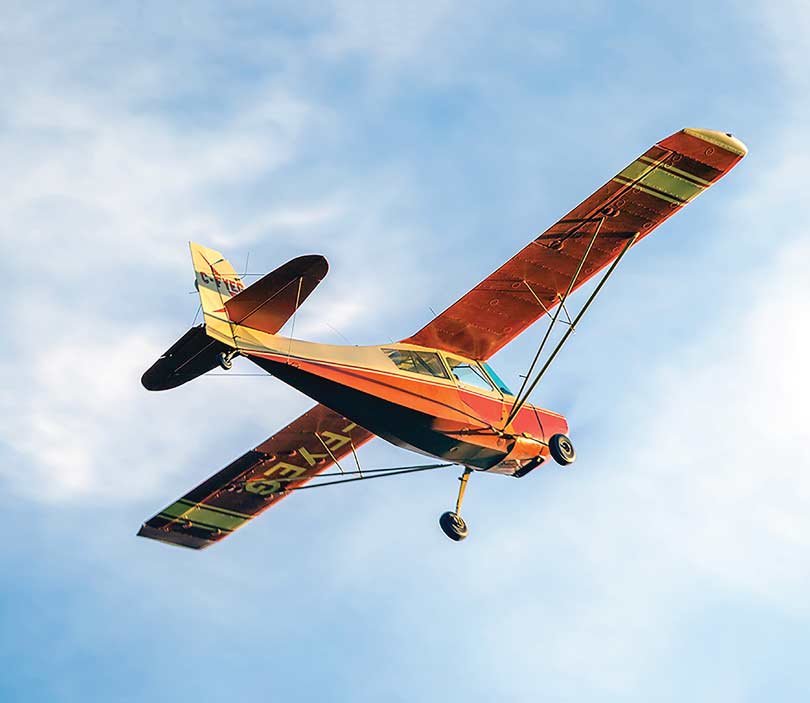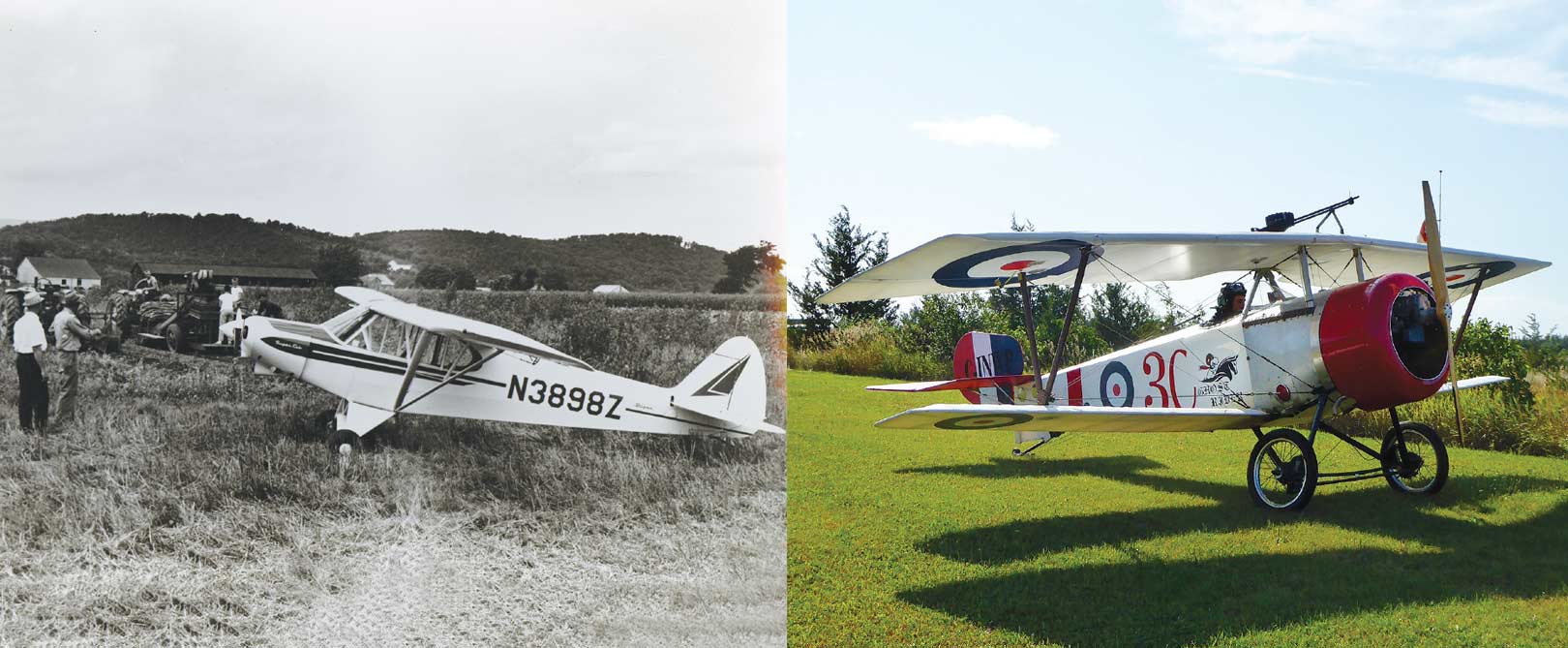


Sharing the feelings of limitless possibilities as they gaze skyward, members of local flying clubs also connect with the earth below them.
Oh! I have slipped the surly bonds of earth And danced the skies on laughter-silvered wings…
The exhilaration of flight captured so vividly in Royal Canadian Air Force pilot John Gillespie Magee Jr.’s poem, “High Flight,” gives us insight into what has long fascinated us about flying, and about those who have mastered it.
“You never forget the first time in the air and that feeling of limitless possibilities. Seeing where you live and your community from the air – it really gives you a completely new perspective,” says Dave Main, former president and current member of the Prince Edward Flying Club (PEFC), based out of Picton airport.
The PEFC is one of a number of local flying clubs in the Watershed area that are connected to an intricate network of private and publicly owned airfields across Ontario. Their members range in age, flying experience and number, but they all share an irrepressible love of flying.
BREAKFAST ON THE FLY
According to Dave, the members of the group, many of whom are retired, look forward to the next seasonal “Fly In.”
He is referring to one of the Club’s most popular events, where a hundred or so pilots and guests “fly in” for breakfast, show off the latest improvements to their planes and officially kick off the flying season. In 2021, the PEFC managed to pull off three Fly-In breakfasts and a dinner, and they hope to start up again in April 2022.
This year also marks PEFC’s 69th anniversary, and even more incredible than the Club’s longevity is the fact that they are still using the same airfield (maintained and resurfaced periodically) and many of the original wartime buildings that were used as World War II training bases.
“The place is like something out of a movie. The mess hall and barracks and a lot of these buildings were used in the 1940s to train both RCAF and Royal Air Force pilots. They had planes like the North American P-51 Mustangs, B-52 Mitchells, de Havilland DHC-1 Chipmunks, and even Douglas C-47 Dakotas here. The base was active until 1969, and the Club moved in in 1953. It’s special to be in this space, but it’s had its challenges too,” comments Dave.
He explains that some of the older Club members remember when the first office was in a former ammunition room. “It was pretty small and had a window with bars on it, poor ventilation, and a stovepipe hole that was hand-drilled through the concrete walls. The stove frequently ‘exploded,’ so if you look at the original pilot log books and documents from those days, they’re covered in black, oily soot.” Despite the financial and physical challenges of working at a historic airfield, it was PEFC’s storied surroundings that attracted the organizers of the 2017 “Vimy Flight: Birth of a Nation” tour, which opted to make a stopover in Picton with their vintage World War I biplane replicas.
“That was a special day. We had hundreds of people come to see these very rare replicas that had made the historic flight over the Vimy Ridge Memorial in France. People had a chance to experience what it was like flying in these planes and appreciate the contributions of Canadian pilots,” recalls Dave proudly.
RICH HISTORY IN WAR AND PEACE
The history of flying clubs in Canada is intrinsically linked with the Canadian war effort. By the end of the First World War, Canada had more than 2,500 trained pilots, but only a small number of aviation jobs. Those who couldn’t find work ended up in flying exhibitions or starting their own passenger and transport businesses, which were largely unregulated and risky.
The Canadian government needed a quick and cost-effective way to support this fledgling industry and the development of its own air force. They recognized the need to invest in flying clubs after witnessing Britain’s success in certifying pilots and sustaining community airfields through the clubs.
If a flying club had an instructor, an aircraft mechanic, at least 30 members that wanted to learn to fly, and a minimum of ten licensed member pilots, they could obtain certification. Once certified, the RCAF would lend the clubs two light aircraft (usually de Havilland DH.60X Moths), and $100 for each pupil qualifying for a pilot’s licence. The RCAF also pledged an additional aircraft for each one purchased by the flying club during its first five years. This program was so successful that by the time the Second World War started, twenty-five Canadian flying clubs were contracted to operate elementary flying training schools for the RCAF.
“This airfield was a really important training base because it was part of the British Commonwealth Air Training Plan. Imagine that they were flying planes like the Avro Anson, Bristol Bolingbroke, and Westland Lysander. It was a hive of activity,” recalls Dave Main.
“Of course we’re a lot quieter nowadays,” he adds. “Picton is now a PPR (Prior Permission Required) airport after it stopped operations in 1969. Basically, you have to call in and get permission to fly into the airport. There aren’t that many flights beyond our club members, and we work hard at maintaining good relationships with our neighbours.”
Dave reveals a key issue that many community flying clubs have had to address: The conversion of the farmland that once surrounded many airfields into residential neighbourhoods has meant tighter restrictions on flying clubs, which in turn has curbed infrastructure development and membership growth.
“A HIDDEN GEM”
Like Dave Main, Dave Muldoon, the president of the Oak Hills Flying Club, which operates out of the Stirling airport, is mindful of maintaining strong ties with his club’s neighbours and the local community.
“The Stirling airport is a hidden gem, even though we’ve been around since 1969. We have 2,350 feet of runway, as well as hangar space and a new clubhouse facility. Our members are active, but it’s not Pearson Airport in Toronto,” he says with a smile.
He adds, “Growing up near Pearson, hearing planes overhead was commonplace. I remember going to a spot off Highway 427 where we would watch in awe as huge commercial planes would land – it seemed a few feet away from us. Planes were a source of inspiration for us, not a nuisance, and that is what we want to be for our local community as well.” The Oak Hills Flying Club has seen an influx of new members recently.
“It’s not just retirees that form our membership,” says Dave. “We’re seeing younger members in their late twenties and thirties join. Many people think flying is only a rich person’s hobby, when in fact it’s very much within reach. We have members who are on a fixed income that fly out on day trips, younger air cadets that want more flying practice, families that fly out on fishing trips or to cottages. We try and keep it affordable.”
Local club memberships are usually between $35 and $50 in the first year and go down in price for subsequent years. You don’t have to own a plane to join in, and sometimes the events take place on the ground.
“If you’re an enthusiast like me who enjoys owning vintage planes, building your own and constantly restoring and tinkering with it, the members become like an expert panel of advisors. We all enjoy talking about our plane builds with anyone who’s interested,” Dave smiles.
He owns a Steen Skybolt, a homebuilt, aerobatic biplane, but he started his aviation career flying a much bigger plane – the de Havilland DHC-5 Buffalo – as a Canadian Search and Rescue pilot.
He recalls one very memorable flight. “We were called into a remote wooded area in B.C., where a small plane had crashed just beyond the runway. It was two dads and their sons who were flying home from a fishing trip. They were seriously injured, and the pilot was in critical condition. The Buffalo aircraft doesn’t need a lot of runway space to take off, but when we got there, we saw that the plane crash was blocking part of the runway, and there were some very tall trees beyond that. We had to offload as much weight as we could from the plane, which included our passenger Barry Smith, who was taking photos for a book about land, sea, and air rescue and had to stay behind. I was co-pilot and so I controlled the throttle. Looking at the treeline, I put the levers to the firewall, and as we took off the pilot turned to me and asked for more power. I had to tell him I was already at the max. We barely made it.”
Despite the adventures and rewards of flying for Search and Rescue, Dave opted to pursue a career as a commercial pilot.
“You can’t spend your whole time with Search and Rescue because it’s pretty demanding, so I started flying commercial planes like the Airbus and Boeing 777 for various airlines. That job was rewarding too, especially when we used to have the kids and their parents visit us in the cockpit. I loved watching their eyes light up when they experienced our view of the sky and the earth below. I knew they were hooked on flying,” remembers Dave, who still keeps a collection of thank-you notes and drawings given to him by the kids who visited him during the flight.
He adds, “That was one of the sad consequences of 9/11. We lost that connection to the next generation when we barred them from that experience. At the Club, one of the goals is a commitment to promoting aviation with young people. We host open house events, and we invite young people to experience flying, even if for an afternoon.”
FLIGHT FOR ALL AGES
The Prince Edward Flying Club also has a strong commitment to promoting aviation to youth through the local COPA (Canadian Owners and Pilots Association) for Kids aviation program. The program pairs volunteer member pilots from flying clubs together with young people between the ages of 8 and 17, to give them the experience of being in the cockpit of an aircraft and actually flying. The program is funded through corporate sponsorship and member donations, and participating youth do not need to have any prior flying experience.
“We have about 25 to 30 kids in the program each year. Our volunteers give them 30 minutes of ground school – where they learn the basics about flying and safety – and then they are off flying over the County. Some of the kids have never flown before,” explains Dave Main.
The COPA for Kids tagline, “Aviators are not born, but they are inspired by other aviators,” also rings true for Dave Muldoon.
“We have a young lady in the club who got into the air cadets thanks to COPA and is now a licensed pilot,” says Dave. “I see how the young girls respond to her and how excited they are to see a female pilot. I think people don’t realize that the Canadian aviation industry employs a high percentage of women.”
He sees an important role for flying clubs in maintaining and fostering new pilots.
“Before the pandemic, Canadian commercial aviation was actually doing well. We had jobs, trained pilots, and a fair bit of innovation in the industry. Now our industry has to change, but I don’t think our love of flying will waver. It’s up to the clubs to inspire and get people flying again,” he says.
“When you fly in a small aircraft, it’s very different from a commercial flight. You’re only going 75 miles per hour in a small plane so you really have time to see things. And you see things that you can only see from the air. I’ve seen bears fishing along the Trent River, the original shoreline of Lake Ontario, crop circles, and the fall colours in Northumberland. You see the human footprint on the landscape, and you gain a new perspective for how our communities are connected and a new appreciation for the environment.”
Flying, it seems, doesn’t just inspire us skyward, but earthward as well.
At the PEFC, registration for the 2022 COPA program opens in June and usually runs in mid- to late August. For more information about the PEFC visit: princeedward-flying-club.com/ and for Oak Hills Flying Club visit: stirlingairport.ca
Story by:
Micol Marotti
Photography by:
David Carnahan,
courtesy PEC Public Library and Archives and John Henderson


